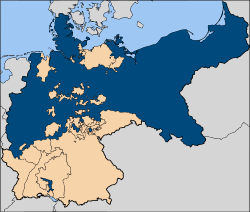
Back Pruise Afrikaans Preussen ALS ፕሩሲያ Amharic Prēossland ANG بروسيا Arabic بروسيا ARZ প্ৰুছিয়া ৰাজ্য Assamese Prusia AST Prussiya Azerbaijani پروس AZB
Kingdom of Prussia Königreich von Preußen (German) | |
|---|---|
| 1525–1947 | |
| Motto: Gott mit uns (High German) Nobiscum deus (Latin) "God with us" | |
| Anthem: Preußenlied
Song of Prussia | |
 Prussia (in blue) at its height as the leading state of the German Empire | |
| Capital | Königsberg (1525–1701) Berlin (1701–1947) |
| Common languages | German (official) |
| Demonym(s) | Prussian |
| Government | Monarchy (until 1918), Republic |
| Duke1 | |
• 1525–1568 | Albert I (first) |
• 1688–1701 | Frederick III (last) |
| King1 | |
• 1701–1713 | Frederick I (first) |
• 1888–1918 | Wilhelm II (last) |
| Prime Minister1, 2 | |
• 1918 | Friedrich Ebert (first) |
• 1933–1945 | Hermann Göring (last) |
| Historical era | Early modern Europe to Contemporary |
| 10 April 1525 | |
| 27 August 1618 | |
| 18 January 1701 | |
| 9 November 1918 | |
| 30 January 1934 | |
| 25 February 1947 | |
| Currency | Reichsthaler German gold mark (1873–1914) German Papiermark (1914–1923) Reichsmark (1924 to the Abolition of Prussia) |
| Today part of | Germany Poland Russia (Kaliningrad Oblast) Lithuania Denmark Belgium Czech Republic Switzerland |
| |
Prussia (/ˈprʌʃə/; German: Preußen, pronounced [ˈpʁɔʏsn̩] (![]() listen), Old Prussian: Prūsa or Prūsija) was a series of countries. Originally it was a historically prominent German state that originated in 1525. Mostly, the name is used for the Kingdom of Prussia, which was in northern Europe. It was part of Germany for a while, and it included land in Poland, France, and Lithuania. The name "Prussian" has had a lot of different meanings in the past and now:
listen), Old Prussian: Prūsa or Prūsija) was a series of countries. Originally it was a historically prominent German state that originated in 1525. Mostly, the name is used for the Kingdom of Prussia, which was in northern Europe. It was part of Germany for a while, and it included land in Poland, France, and Lithuania. The name "Prussian" has had a lot of different meanings in the past and now:
- The land of the Baltic Prussians (today parts of southern Lithuania, Kaliningrad, and north-eastern Poland);
- The lands of the Teutonic Knights (a group of religious soldiers in the 12th century);
- Part of the lands of the Polish Crown, Royal Prussia;
- A fief of the Polish Crown, Ducal Prussia, later under control of the Hohenzollern family of Brandenburg;
- All Hohenzollern land, inside or outside Germany;
- An independent Kingdom, from the 17th century until 1871;
- The largest part of the German Empire, the Weimar Republic, and Nazi Germany from 1871 to 1945.
In 1934, Germany stopped using the name Prussia for that area, and in 1947 the Allies abolished the state of Prussia and divided its territory among themselves and the new States of Germany. Today, the name is only for historical, geographical, or cultural use.
The name Prussia comes from the Borussi or Prussi people who lived in the Baltic region and spoke the Old Prussian language. Ducal Prussia was a fiefdom of the Kingdom of Poland until 1660, and Royal Prussia was part of Poland until 1772. In the late eighteenth and early nineteenth centuries, most German-speaking Prussians started thinking of themselves as part of the German nation. They thought the Prussian way of life was very important:
- Perfect organization
- Sacrifice (giving other people something you need)
- Obeying the law
From the late 18th century, Prussia had a lot of power in northern Germany and throughout central Europe; it was the strongest in politics and economics, and it had the most people. After Chancellor Otto von Bismarck dissolved the German Confederation, Prussia annexed almost all of northern Germany. In 1871, after the Franco-Prussian War, von Bismarck created the German Empire, and Prussia was the center of the empire, with the Kings of Prussia being the Emperors of Germany.
© MMXXIII Rich X Search. We shall prevail. All rights reserved. Rich X Search



